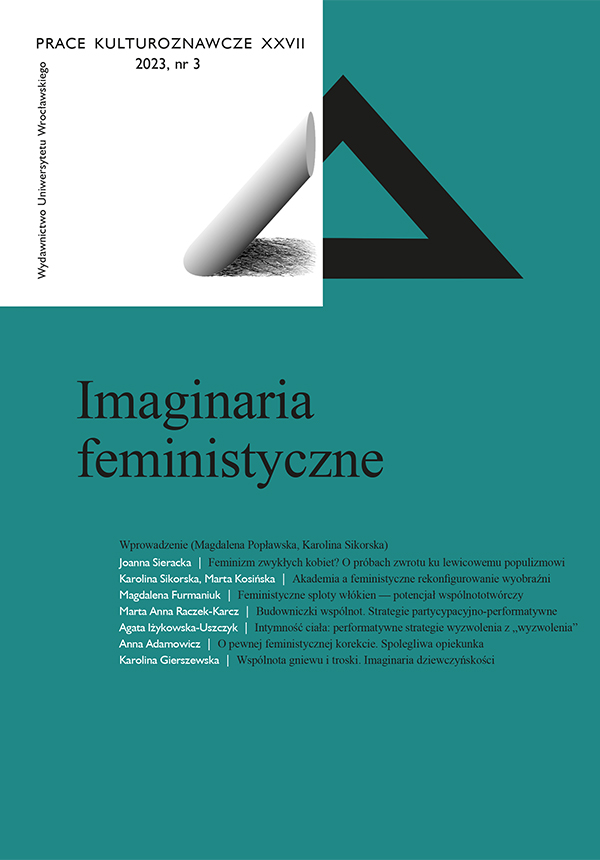

Articles

This paper presents an analysis of the performative-participatory nature of creative activities undertaken in the field of graphic arts in the last decade. This formula of the artist-work-recipient relationship (which is relatively novel for graphic arts) is described using the concept of participatory art in accordance with the approach proposed by Claire Bishop in 2012. The concept of graphic dispositive is then redefined to supplement this methodology. In the course of the analyzed projects, it undergoes a farreaching transformation compared to the form in which it previously functioned in graphic arts. The reflection undertaken in the article emphasizes the community-creating nature of the activities of two graphic artists, Zuzanna Dyrda (Poland) and Priscilla Romero Cubero (Costa Rica), pointing to the role that the artistic practice proposed by each of them plays in transforming the perception of the graphic medium in the current field of art. The discussed projects are both significant contributions to the development of graphic arts in the so-called expanded field and serve as good examples of the possibilities available to this artistic medium in terms of animating, raising awareness and building micro- and macro-communities based on the emotional involvement of recipients and emphasizing corporeality as an important aspect of constituting emotions.
Agent of Change: Print Culture Studies after Elizabeth L. Eisenstein, red. S. Alcorn Baron, E.N. Lindquist, E.F. Shevlin, Amherst-Boston 2007.
Ascott R., Telematic Embrace: Visionary Theories of Art, Technology, and Consciousness, Berkeley-Los Angeles 2007.
Bailey S., Beyond Hope and Despair: Staying with the Present, [w:] Sean Caulfield: Active Workings [katalog wystawy], Vernon 2018, s. 9–11.
Bishop C., Artificial Hells: Marticipatory Art and the Politics of Spectatorship, London 2012.
Bishop C., Sztuczne piekła. Sztuka partycypacyjną i polityka widowni, przeł. J. Staniszewski, Warszawa 2015.
Dane J.A., The Myth of Print Culture: Essays on Evidence, Textuality, and Bibliographical Method, Princeton-Toronto-Buffalo-London 2003.
Eisenstein E.L., The Printing Press as an Agent of Change: Communications and Cultural Transformations in Early-Modern Europe, Cambridge-London-New York-Melbourne 1979.
Giziński K., Zapośredniczona bezpośredniość — lateksografia jako uniwersalna technika graficzna, [w:] Ucieleśniona pamięć. Wystawa prac Priscilli Romero Laureatki MTG Kraków 2018, red. M.F. Woźniak, Bydgoszcz 2019.
Hogan J., The performative print: Alick Tipoti’s „Girelal”, „Artlink Magazine” 32, 2012, nr 2, https://www.artlink.com.au/articles/3795/the-performative-print-alick-tipotis-girelal/.
Hollender H., Czy świat czeka przyszłość średniowiecza, przeł. H. Holledenr, [wkładka w:] E.L. Eistenstein, Rewolucja Gutenberga, przeł. H. Hollender, Warszawa 2004.
Jurkowlaniec G., Sprawczość rycin. Rzymska twórczość graficzna Tomasza Tretera i jej europejskie oddziaływanie, Kraków 2020.
Kluszczyński R.W., Sztuka interaktywna. Od dzieła instrumentu do interaktywnego spektaklu, Warszawa 2010.
Print and Power in Early Modern Europe (1500–1800), red. N. Lamal, J. Cumby, H.J. Helmes, Leiden-Boston 2021.
Rodriguez F.E., Ucieleśniona pamięć — ślad wyrażający prawdę Priscilli Romero, [w:] Ucieleśniona pamięć. Wystawa prac Priscilli Romero Laureatki MTG Kraków 2018, red. M.F. Woźniak, Bydgoszcz 2019.
The Perils of Print Culture: Book, Print and Publishing History in Theory and Practice, red. J. McElligott, E. Patten, New York 2014.